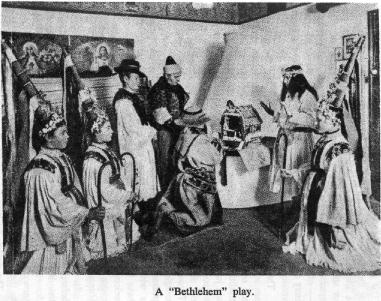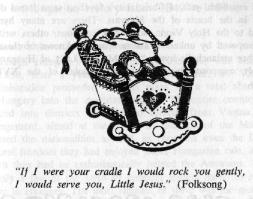| Timeless Nation |
21. "SHEPHERDS AND KINGS.
(The Christian inspiration of Hungarian folk poetry)
The old religion of the pre-Settlement Magyars presented remarkable similarities to Christianity. Its moral and theological structure was basically that of a monotheistic, animistic faith, based on the adoration of one God ("Isten") and respect and veneration for many spirits, such as the spirits of their departed ancestors and angel-like super-beings. These were respected in much the same way that Christianity respects its saints, angels and the memory of departed souls. Thus the ancient Magyar religion cannot be called "paganism" in the polytheistic sense of the Greco-Roman or Assyrian-Babylonian religions.
Christianity has often accepted and used the framework of certain pagan myths and festivals, replacing them with its own liturgical content. Thus the Magyars found it congenial to celebrate the mysteries of Christianity, such as Christmas, Easter, Whitsun and the feasts of some saints (especially those of the Blessed Virgin), by providing them with the colour and warmth of their own millenia-old poetic myths and rites. Folk poems, ballads, legends, anecdotes and dramatic presentations connected with Christian festivals abound among the Magyar people of all denominations. This folk poetry of Christian inspiration offers a fascinating field of folklore study, hitherto not sufficiently explored.
The language of Christian liturgy has provided the people with a rich store of relgious phraseology. The colourful imagery of Christian liturgy has always appealed to the anonymous poets of the people who adopted this inspiration with their characteristic emotional-religious nationalism.
The richest treasure of religious folk poetry is found in plays and songs connected with Christmas. Many Christmas carols are sung in connection with the Church service, others form part of the Bethlehem plays.
This time of the year, the winter solstice – the resurrection of the sun after the shortest day of the year December 22 –used to herald the increase of life-giving sunshine in pagan liturgy. Thus from time immemorial this has been the season of festivities. The pagans used to celebrate the Sun-God, the Christians the birth of Christ, their "Life-giving Sun". Ancient rites have been Christianised, but memories of old festivities of the Sun still linger in Hungarian folk hymns, such as the refrain of a popular carol: "Oh life, oh sunshine – Oh dear little Jesus."

The role of the humble herdsmen in tbe Bethlehem story has always appealed to the Magyar peasant. Some carols present a cheerful, dance rhythm, such as the "Shepherds’ Dance" from Central Hungary. Some carols of a more solemn nature begin with the Latin words of the Catholic liturgy. The angels’ call to the herdsmen of Bethlehem on Christmas night inspired many folk carols. The best-known of these: "Herdsmen . . . ", first recorded in a XVIIth century hymn book, is found in many varieties in all Magyar-speaking areas.
One of the most popular carols, known in Transylvania and the Great Plain, begins with the Greek words of the Catholic liturgy (slightly Magyarised): "Kirje, kirje. . .". The naive charm of the text and the purity of the ancient tune leave no doubt that we hear one of the genuine creations of the people, probably the Szekelys of eastern Transylvania from where it must have spread to the other regions. Here the majestic Christ of the liturgy becomes a sweet little baby surrounded by His mother and simple shepherds, worried about the cold and wishing they could give the Divine Child the comfort which, according to the gospel, had been denied to Him in Bethlehem.
Another shepherd-carol, "Shepherds..." is known in many regions. Both the text and the melody are folk creations and show no scholarly influence. This simple folk hymn has become a standard part of the Christmas Midnight Masses in Hungary.
The commemoration of Jesus Christ’s birth in Bethlehem has been the subject of festival plays and puppet-shows presented at Christmas time in all Christian countries since the Middle Ages. These Bethlehem-plays, impromptu dramatic performances, have become part of the Hungarian peasants’ Christmas celebrations too. Performed by troupes of children or adults, these plays are often combined with presentations of puppets, accompanied by songs and musical instruments, and sometimes even dancing. The scene is usually the stable with Mary and Joseph standing at the manger in which the child Jesus – a doll or sometimes a live baby – is lying. The herdsmen arrive during the play or stand at the manger when the play starts. Angels and other symbolic characters – representing the good and bad principles – often take part in the play. In some regions the child-actors may even take the manger to church and perform there a shorter version of the play.
The songs and texts have many variations and the costumes are sometimes quite elaborate. In the Catholic regions the texts are serious and conform more or less with the church texts and traditions. In the Protestant regions (where the Bethlehem plays are just as popular), the actors often improvise and add a touch of comedy to the play. Their principal actor may be a sleepy old shepherd on whom the youngest boys play various tricks. Throughout the play improvisations – humorous or earnest –mingle with beautiful old folk hymns. In many songs the peasants’ naive, nostalgic devotion is presented in the form of a wish: "If Jesus had been born in Hungary, things would have been different He would certainly have received a warmer welcome from his Magyar shepherds". In the Appendix we quote extracts from a Bethlehem play recorded in western Hungary.
In some Bethlehem plays, marionettes are made to dance before the manger. They represent symbolic characters: Death, the devil, angels, shepherds, peasants, Herod, soldiers. Candles decorate the elaborate puppet stage and they flicker in the cold, snowy night of the village as the children move from one house to the next.
The deeply emotional carol "A Beautiful Rose" sums up the spirit of these Bethlehem plays as it paints a picture of the Holy Virgin bending over the manger where her Son, the "Beautiful Flower" sleeps: Jesus, who brought sunshine and life to the Earth. Thus Christian and ancient thoughts meet in harmony in the humble, rustic image of the candle4it scene of Bethlehem.
On the 6th of January (Epiphany), the Three Wise Men (the Magi or Three Kings) are remembered by the re-enactment of the scene described in the gospels. Three children – often girls dressed in white robes with mitres, and holding long stocks (sceptres), represent the three Kings. They are often preceded by an "angel" holding a "star" on a pole. They enter each house, calling on the people to "seek the Star over Bethlehem…" Their play is connected with the Bethlehem plays and contains carols of a similar nature.

The customs connected with Easter show, curiously enough, little Christian inspiration. The same is the case with Saint Ivan’s Day (Midsummer Day, June 22), as mentioned in the previous chapters. The Whitsun customs, such as the Whitsun-Queen procession, mingle Christian and pagan elements. (cf. Chapter11).
Of the saints, Saint Stephen, the first king of Hungary, is often remembered in songs. As is the case with the other saints’ days, the people who bear the saint’s name celebrate their "name-day" and are congratulated, often in flowery verse.
The Magyars accepted Christianity during the XIth century with some reluctance, directed not against the faith but against the foreigners brought to Hungary to propagate it. Once, however, the Christian faith, and with it western civilisation, had been accepted, it became the nation’s own heritage, jealously defended through centuries of wars. The new faith became a Hungarian religion, and Christian devotion and Magyar patriotism became synonymous notions. The Magyars began to regard themselves as soldier-knights of Christ and of the Holy Virgin, the "Patron of Hungary". They have an almost romantic veneration for the Virgin Mary, the "Great Queen of Hungary". (By a strange turn of fate, Hungary never had a Hungarian-born queen). Since the XVIllth century, Catholics have often referred to Hungary as "Regnum Marianum" (Mary’s Kingdom").
This emotional cult of Christianity’s loveliest saint found deep echoes in the hearts of the Magyars. There are many hymns devoted to the Holy Virgin, some folk creations, others written and composed by unknown artists. The best-known of these is the rather melancholic hymn "Our Mother, Lady of Hungary probably composed by an unknown schoJar of the XVIlth century.

| Timeless Nation |